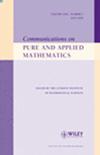“微分模型的全局可辨识性”的勘误
IF 3.1
1区 数学
Q1 MATHEMATICS
引用次数: 0
摘要
我们感谢彼得·汤普森指出了[1,引理3.5,第1848页]中的一个错误。最初的证明只有在θ´$\hat{\ θ}$是一个常数向量的假设下才有效。然而,θ θ $\hat{\bm{\theta}}$的一些分量可以是所考虑的动态状态,引理在后面的[1,命题3.4]中被用于这样的设置(即θ θ $\hat{\bm{\theta}}$涉及状态)。我们给出了一个更明确的版本,并提供了一个正确的证明。我们想要的表述将从下面推导出来:引理1。考虑一个微分方程组x1 ' = f1 (x,μ,u),⋮xn”= fn (x,μ,u), $ $ \开始{方程}{\{病例}开始x_1 ^ {\ '} = f (\ bm {x} \ bm{\μ}\ bm{你}),\ \ \ vdots \ \ x_n ^ {\ '} = fn (\ bm {x} \ bm{\μ}\ bm{你}),结束\{病例}}\{方程}$ $结束(1)x = (x1,…,xn)美元\ bm {x} = (x_1、\ ldots x_n)美元和u = (u1,……,嗯)美元\ bm{你}= (u_1 \ ldots, u_m)美元的元组微分不定,μ=(μ1,…,μλ)美元\ bm{\μ}=(\μ_1 \ ldots \μ_ \λ)美元是标量参数,和f1,…,fn∈C (x,μ,u) $ f \ ldots,f_n \in \mathbb {C}(\bm{x}, \bm{\mu}, \bm{u})$。让问(x,μ,u)∈C (x,μ,u)问美元(\ bm {x} \ bm{\μ}\ bm{你})中\ \ mathbb {C} [\ bm {x} \ bm{\μ}\ bm{你}]美元的LCM f1的分母,…,fn $ f \ ldots fn美元。设P∈C[x,μ]{u}$P \in \mathbb {C}[\bm{x}, \bm{\mu}]\lbrace \bm{u}\rbrace$是一个非零微分多项式。然后存在非零P1∈C (x,μ)P_1美元\ \ mathbb {C} [\ * bm {x} \ bm{\μ}]美元和P2∈C{你}$ P_2 \ \ mathbb {C} \ lbrace \ bm{你}\ rbrace美元,每一个元组μ̂Cλ∈\美元的帽子{\ bm{\μ}}\中\ mathbb {C} ^ \λ美元每个幂级数解(x̂,u) $ ({\ * bm {x}} \帽子,帽子\ {\ bm{你}})美元(1)的参数μ̂美元\帽子{\ bm{\μ}}在C [[t]]美元\ mathbb {C} [\ [t] \ !]美元这样问(x̂,μ̂,u) | t = 0≠0 $ $ \{方程*}开始问(\帽子{\ * bm {x}} \帽子{\ bm{\μ}},\帽子{\ bm{你}})| _ {t = 0} \ 0 ne \{方程*}$ $结束我们P1 (x̂,μ̂)| t = 0≠0,P2 (u) | t = 0≠0⇒P (x̂,μ̂,u)≠0。$ ${方程*}{\ \开始离开(P_1 ({\ * bm {x}} \帽子,帽子\ {\ bm{\μ}})| _ {t = 0} \ 0 ne \; \, \;P_2(\帽子{\ bm{你}})| _ {t = 0} \ 0 ne \右)}\ Rightarrow P(\帽子{\ * bm {x}} \帽子{\ bm{\μ}},帽子\ {\ bm{你}})\ 0。结束\{方程*}$ $的证明。考虑下面的微分理想我:=⟨(Qxi−Qfi) (j)、P (j)∣1⩽我⩽n, j⩾0⟩:问∞⊂C(μ){x, u}。$ $ \{方程*}我开始:= \ langle (Qx_i ^ {\ '} - Qf_i) ^ {(j)}, P ^ {(j)} \ 1 \ leqslant我\ leqslant n,中期\;j \geqslant 0 \rangle: Q^\ inty \子集\mathbb {C}[\bm{\mu}]\lbrace \bm{x}, \bm{u}\rbrace。我们声明I包含一个形式为P1P2$P_1P_2$的非零多项式,使得P1∈C[x,μ]$P_1 \in \mathbb {C}[\bm{x}, \bm{\mu}]$和P2∈C{u}$P_2 \in \mathbb {C}\lbrace \bm{u}\rbrace$。首先,我们将证明,如果断言为真,那么P1和P2满足引理的条件。相反,假设有一个幂级数解(x̂,u) $ ({\ * bm {x}} \帽子,帽子\ {\ bm{你}})美元(1)的参数μ̂美元\帽子{\ bm{\μ}}$的常数项Q (x̂,μ̂,u) P1 (x̂,μ̂)P2 (u)问美元({\ * bm {x}} \帽子,帽子\ {\ bm{\μ}},帽子\ {\ bm{你}})P_1 ({\ * bm {x}} \帽子,帽子\ {\ bm{\μ}})P_2(\帽子{\ bm{你}})美元零但P (x̂,μ̂,u) = 0 $ P ({\ * bm {x}} \帽子,帽子\ {\ bm{\μ}},帽子\ {\ bm{你}})= 0美元。由于(x³,μ³,û)$(\hat{\bm{x}}, \hat{\bm{\mu}}, \hat{\bm{u}})$是微分多项式P和Qxi ' - Qfi$Qx_i^{\素数}- Qf_i$的零,对于每一个1≤i≤n$1 \leqslant i \leqslant n$,它是理想⟨(Qxi ' - Qfi)(j),P(j)∣1≤i≤n,j≠0⟩的零。$ ${方程*}\ \开始langle (Qx_i ^ {\ '} - Qf_i) ^ {(j)}, P ^ {(j)} \中期1 \ leqslant \ leqslant n \;J \geqslant 0 \rangle。\{方程*}$ $结束以来Q (x̂,μ̂,u) | t = 0≠0美元Q ({\ * bm {x}} \帽子,帽子\ {\ bm{\μ}},帽子\ {\ bm{你}})| _ {t = 0} \ 0美元,在我每一个元素,这是上面的理想的饱和,也消失在(x̂,μ̂,u)美元({\ * bm {x}} \帽子,帽子\ {\ bm{\μ}},帽子\ {\ bm{你}})美元。特别是,P1P2 P_1P_2消失在美元(x̂,μ̂,u)美元(\帽子{\ * bm {x}} \帽子{\ bm{\μ}},\帽子{\ bm{你}})美元,我们到达的矛盾与P1 (x̂,μ̂)P2 (u)≠0美元P_1(\帽子{\ * bm {x}} \帽子{\ bm{\μ}})P_2(\帽子{\ bm{你}})\ 0美元。现在我们来证明这个说法。考虑环R: = C (x,μ){你}[1 / Q] $ R: = \ mathbb {C} [\ * bm {x} \ bm{\μ}]\ lbrace \ bm{你}\ rbrace [1 / Q]美元。设J是r中I∩C[x,μ]{u}$I \cap \mathbb {C}[\bm{x}, \bm{\mu}]\lbrace \bm{u}\rbrace$生成的理想。通过Q处的饱和定义I意味着J∩C[x,μ]{u}=I∩C[x,μ]{u}。$ $ \{方程*}开始J \帽\ mathbb {C} [\ bm {x}, {\ bm{\μ}}]\ lbrace \ bm{你}\ rbrace =我\帽\ mathbb {C} [\ bm {x}, {\ bm{\μ}}]\ lbrace \ bm{你}\ rbrace。因此,足以证明存在一个形式为P1P2$P_1 P_2$的元素,其中P1∈C[x,μ]$P_1 \in \mathbb {C}[\bm{x}, \bm{\mu}]$, P2∈C{u}$P_2 \in \mathbb {C}\lbrace \bm{u}\rbrace$ in j。我们在R上定义一个导数L$\mathcal {L}$(基本上是李氏导数):=∑i=1nfi∂g∂xi+∑j=0∞u R (j+1)∂g∂u R (j)forg∈R。$ ${方程*}\ \开始mathcal {1} (g): = \ \和限制_ {i = 1} ^ n f_i \压裂{\部分g}{\部分x_i} + \ \和限制_{\魔法= 1}^ m \ \和限制_ {j = 0} ^ \ infty u_ \字母L ^ {(j + 1)} \压裂{\部分g}{\部分u_ \魔法^ {(j)}} \四\文本为}{g \ R。 由于Qx1 '−Qf1,…,Qxn '−Qfn∈I$Qx_1^{\素数}- Qf_1, \ldots, Qx_n^{\素数}- Qf_n \in I$和I是微分理想,J在L$\mathcal {L}$下是不变的。设R ~ $\ widdetilde {R}$是R对C{u}$\mathbb {C}\lbrace \bm{u}\rbrace$的定位,J ~ $\ widdetilde {J}$是J在这个定位中产生的理想值。推导L$\mathcal {L}$可以自然地扩展到R ~ $\ widdetilde {R}$,并且J ~ $\ widdetilde {J}$也是L$\mathcal {L}$-不变的。足以证明J ~∩C[x,μ]≠{0}$\ widdetilde {J}\cap \mathbb {C}[\bm{x}, \bm{\mu}] \ne \lbrace 0\rbrace$。考虑一个J ~∩C[x,μ]{u}$\ widdetilde {J} \cap \mathbb {C}[\bm{x}, \bm{\mu}]\lbrace \bm{u}\rbrace$的非零元素,它具有最小的单项式个数,并且在这些元素中,有一个总度最小的元素。我们称之为S。如果S∈C[x,μ]$S\in \mathbb {C}[\bm{x}, \bm{\mu}]$,我们就完成了。否则,u中的一个出现在S中,比如u1。设h=ordu1S$h = \operatorname{ord}_{u_1}S$。由于R ~ $\widetilde{R}$是一个诺瑟环,因此存在N>0$N >0$使得LN(S)∈⟨S,L(S),…,LN−1(S)⟩。$ ${方程*}\ \开始mathcal {L} ^ N (S) \ \ langle年代\ mathcal {1} (S) \ ldots \ mathcal {L} ^ {N - 1} \捕杀。$$我们有ordu1Li(S)<N+h$\operatorname{ord}_{u_1} \mathcal {L}^i(S) <N$i <N$i <N和LN (S) =∂年代美元∂u1 (h) u1 (h + N) + T, whereordu1T< N + h。$ ${方程*}\ \开始mathcal {L} ^ N (S) = \压裂{\部分年代}{\部分u_1 ^ {(h)}} u_1 ^ {(h + N)} + T,{在}\ \四\文本operatorname{奥德}_ {u_1} T & lt;N + h。\{方程*}$ $因此结束,我们有∂年代∂u1 (h)∈⟨年代,L (S),…,LN−1 (S)⟩⊂J∼。$$\begin{equation*} \frac{\partial S}{\partial u_1^{(h)}} \in \langle S, \mathcal {L}(S), \ldots, \mathcal {L}^{N - 1}(S) \rangle \子集\ widdetilde {J}。$$ $如果S可以被u1(h)$u_1^{(h)}$整除,那么S/u1(h)∈J ~ $S / u_1^{(h)} \in \ widdetilde {J}$将具有相同数量的单项式,但阶数更小,这与S的选择相矛盾。因此,∂S∂u1(h)$\frac{\偏S}{\偏u_1^{(h)}}$的单项式比S少,因此与S的选择相矛盾。□$\Box$P. 1848]但明确地强调了θ n $\hat{\bm{\theta}}$的一些条目可能是初始条件,而不仅仅是系统参数。推论1。(澄清版本的[[1],引理3.5,p . 1848])的符号(1,2.2节),让p(μx, u,…,u (N))∈C[μ,x]{你}$ p (\ bm{\μ}\ bm {x}, u, \ ldots u ^ {(N)})中\ \ mathbb {C} [\ * bm{\μ}\ bm {x}] \ lbrace u \ rbrace美元是零。然后存在非空的Zariski开子集Θ⊂Cs美元\θ{\子集}\ mathbb {C} ^{年代}$和U⊂C∞(0)美元U \ \子集mathbb {C} ^ {\ infty}(0),美元每θ̂=(μ̂,x̂*)∈Θ美元\帽子{\ bm{\θ}}=(\帽子{\ bm{\μ}},帽子\ {\ bm {x}} ^ \ ast) \ \θ,美元U∈\帽子{你}\ U的美元,和相应的x̂= x(θ̂,U)美元\帽子{\ bm {x}} = x(\帽子{\ bm{\θ}},{你}\帽子),美元函数P(μ̂,x̂,U,…,(U) (N)) $ P(\帽子{\ bm{\μ}},{\ * bm {x}} \帽子,\帽子{你}\ ldots,帽子(\{你})^ {(N)})是一个非零元素的C∞(0)美元\ mathbb {C} ^ {\ infty} (0) .Proof美元。我们将引理1应用于模型Σ和命题中的多项式P,得到多项式P1(x,μ)$P_1(\bm{x}, \bm{\mu})$和P2(u)。我们分别用P1≠0$P_1 \ne 0$和P2(U)|t=0≠0$P_2(\bm{U})|_{t =0} \ne 0$来定义Zariski开集Θ和U。引理意味着,(μ̂,x̂∗)∈Θ美元(\帽子{\ bm{\μ}},帽子\ {\ bm {x}} ^ *) \中\θ和u∈\美元的帽子在u ${你}\ P(μ̂,x̂,u,…,(u) (N)) $ P(\帽子{\ bm{\μ}},帽子\ {\ bm {x}},{你}\帽子,\ ldots,帽子(\{你})^ {(N)})将一个非零函数。□\美元美元本文章由计算机程序翻译,如有差异,请以英文原文为准。
Erratum for “Global Identifiability of Differential Models”
We are grateful to Peter Thompson for pointing out an error in [1, Lemma 3.5, p. 1848]. The original proof worked only under the assumption that is a vector of constants. However, some of the components of could be the states of the dynamic under consideration, and the lemma was used in such a setup (i.e., with involving states) later in [1, Proposition 3.4].
We give a more explicit version of the statement and provide a correct proof. The desired statement will be deduced from the following:
The following corollary is equivalent to [1, Lemma 3.5, p. 1848] but explicitly highlights that some of the entries of may be initial conditions, not only system parameters.
求助全文
通过发布文献求助,成功后即可免费获取论文全文。
去求助
来源期刊
CiteScore
6.70
自引率
3.30%
发文量
59
审稿时长
>12 weeks
期刊介绍:
Communications on Pure and Applied Mathematics (ISSN 0010-3640) is published monthly, one volume per year, by John Wiley & Sons, Inc. © 2019.
The journal primarily publishes papers originating at or solicited by the Courant Institute of Mathematical Sciences. It features recent developments in applied mathematics, mathematical physics, and mathematical analysis. The topics include partial differential equations, computer science, and applied mathematics. CPAM is devoted to mathematical contributions to the sciences; both theoretical and applied papers, of original or expository type, are included.

 求助内容:
求助内容: 应助结果提醒方式:
应助结果提醒方式:


